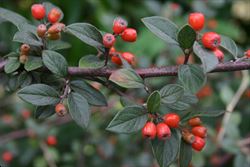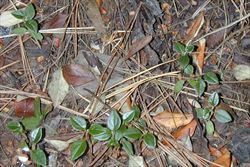Click on images to enlarge

infestation (Photo: Forest and Kim Starr, USGS)

habit (Photo: Trevor James)

older stem, leaves and mature fruit (Photo: Trevor James)

younger stem and leaves (Photo: Trevor James)

lower surfaces of leaves (Photo: Trevor James)

close-up of leaves and mature fruit (Photo: Forest and Kim Starr, USGS)

leaves and mature fruit (Photo: Trevor James)

close-up of seeds (Photo: Forest and Kim Starr, USGS)

seedlings (Photo: Forest and Kim Starr, USGS)
Scientific Name
Cotoneaster franchetii Boiss.
Synonyms
Cotoneaster buxifolius Wall. ex Lindl.
Family
Malaceae (New South Wales)Rosaceae (Queensland, the ACT, Victoria, Tasmania, South Australia and Western Australia)
Common Names
cotoneaster, Franchet cotoneaster, Franchet's cotoneaster, grey cotoneaster, orange cotoneaster, rockspray cotoneaster, silverleaf cotoneaster
Origin
This species is native to south-western China, northern Myanmar and northern Thailand.
Cultivation
A commonly grown garden ornamental in the temperate regions of Australia.
Naturalised Distribution
Naturalised mainly around populated areas in south-eastern Australia. It is scattered throughout the tablelands of eastern New South Wales and is also present in the ACT, Victoria and Tasmania.
Habitat
A weed of gardens, bushland, open woodlands, grasslands, forest margins, waterways, roadsides, railway lines and waste areas in temperate regions.
Habit
A shrub or small tree with an upright (i.e. erect) or arching habit that usually grows about 2-3 m tall, but occasionally reaches up to 5 m in height. This species usually loses some or all of its leaves during winter (i.e. it is semi-deciduous or deciduous).
Distinguishing Features
- a shrub or small tree with an upright or arching habit (2-3 m tall) that loses its leaves during winter.
- its branchlets and the undersides of it sleaves are densely covered in felty hairs.
- its leaves are relatively small (20-35 mm long and 7-18 mm wide) and their upper surfaces become hairless and shiny as they mature.
- its pink or pinkish-white flowers (about 10 mm across) are borne in clusters along the branches.
- its small fleshy 'berries' (5-10 mm across) turn orange-red or pinkish-orange as they mature and contain three small 'seeds'.
Stems and Leaves
The upright (i.e. erect) stems grow in a somewhat spreading and arching nature as the plant matures. Older branches are usually dark brown or greyish-black in colour and hairless (i.e. glabrous), while younger stems are greenish and densely covered in felty hairs.
The alternately arranged leaves are small (20-35 mm long and 7-18 mm wide) and oval (i.e. elliptic) or egg-shaped in outline (i.e. ovate). They have entire margins, pointed tips (i.e. acute or acuminate apices) and are borne on short stalks (i.e. petioles) only 1-4 mm long. Their upper surfaces are greyish-green and somewhat hairy (i.e. pubescent) when young, but become hairless (i.e. glabrous) and shiny in appearance as the leaves mature. Their lower surfaces are densely covered in felty hairs (i.e. they are pubescent) and have a whitish or silvery appearance.
Flowers and Fruit
The pink or pinkish-white coloured flowers (6-10 mm across) are borne in clusters (i.e. corymbs) along the branches, each cluster containing 5-15 flowers. These flowers have five relatively upright (i.e. erect) petals (3-4 mm long and 2-3 mm wide) with rounded tips (i.e. erect apices) and five tiny sepals (1-2 mm long and 1.5-2.5 mm wide). They also have about 20 stamens and 2-5 styles. They are borne on stalks (i.e. pedicels) 2-4 mm long that are densely hairy (i.e. pubescent). Flowering occurs during spring and summer.
The small fruit (5-10 mm across) is a rounded (i.e. globose) or egg-shaped (i.e. ovoid) 'berry' (i.e. actually a pome). These fruit turn orange-red, red or pinkish-orange as they mature and usually contain three small 'seeds' (i.e. nutlets or pyrenes). They are initially hairy (i.e. pubescent), but become hairless (i.e. glabrous) as they mature.
Reproduction and Dispersal
This plant reproduces by seeds which are often spread by birds that eat the brightly coloured 'berries' (i.e. pomes). The fruit are also dispersed in dumped garden waste. If plants are cut down they will produce suckers from the base (i.e. the crown).
Environmental Impact
Grey cotoneaster (Cotoneaster franchetii) is regarded as an environmental weed in Tasmania, Victoria, the ACT and New South Wales. It is the most invasive of the cotoneasters that are found in the Blue Mountains region in New South Wales. This species, like the other cotoneasters, forms thickets under tall trees and dense infestations will displace local native plant species. This invasive process modifies or removes the habitat of local wildlife and also allows other weeds to invade.
Other Impacts
The fruit of this species are considered to be quite poisonous to humans. Grey cotoneaster (Cotoneaster franchetii) can also act as a host for bacterial fireblight, a disease of orchards.
Legislation
This species is declared under legislation in the following states and territories:
- ACT: C4 - prohibited pest plant (a pest plant whose propagation and supply is prohibited).
- Western Australia: Unassessed - this species is declared in other states or territories and is prohibited until assessed via a weed risk assessment (throughout the entire state).
Management
For information on the management of this species see the following resources:
- the Weeds in your Bush section of the Tasmanian Bushcare Toolkit which is available online at http://www.dpiw.tas.gov.au.
Similar Species
Grey cotoneaster (Cotoneaster franchetii) is very similar to large-leaved cotoneaster (Cotoneaster glaucophyllus), silver-leaved cotoneaster (Cotoneaster pannosus), willow-leaved cotoneaster (Cotoneaster salicifolius), milk-flower cotoneaster (Cotoneaster coriaceus) and khasia berry (Cotoneaster simonsii). These species can be distinguished by the following differences:
- grey cotoneaster (Cotoneaster franchetii) has relatively small leaves (20-35 mm long) with greyish-green upper surfaces that are somewhat hairy (i.e. pubescent) when they are young, but become hairless (i.e. glabrous) and shiny in appearance as they mature. The lower surface of the leaves are silvery or whitish in colour and densely hairy (i.e. pubescent). The pink or pinkish-white flowers have relatively upright (i.e. erect) petals and are borne in medium-sized clusters (usually with 5-15 flowers). Its fruit turn orange or pinkish-orange as they mature and usually contain three 'seeds' (i.e. pyrenes).
- large-leaved cotoneaster (Cotoneaster glaucophyllus) has relatively large leaves (20-80 mm long) with upper surfaces that are smooth and dark green in colour. The lower surface of the leaves are initially greyish-green and covered in whitish hairs (i.e. they are pubescent) but these hairs often wear off as the leaves mature, leaving pale green or slightly bluish-green and hairless (i.e. glabrous) undersides. The white flowers have spreading petals and are usually borne in large clusters (usually with 20-60 flowers). Its relatively glossy fruit turn bright red as they mature and usually contain two 'seeds' (i.e. pyrenes).
- silver-leaved cotoneaster (Cotoneaster pannosus) has relatively small leaves (10-40 mm long) with dull greyish-green upper surfaces that are somewhat hairy (i.e. pubescent). The lower surface of the leaves are silvery or whitish and densely hairy (i.e. pubescent). The white flowers have spreading petals and are borne in medium-sized clusters (usually with 6-20 flowers). Its relatively dull and sometimes hairy fruit turn red as they mature and usually contain two 'seeds' (i.e. pyrenes).
- willow-leaved cotoneaster (Cotoneaster salicifolius) has relatively long and narrow leaves (25-90 mm long) with dark green, glossy and hairless (i.e. glabrous) upper surfaces that have prominent veins impressed into them. The lower surface of the leaves are greyish in colour and hairy (i.e. pubescent). The white flowers have spreading petals and are borne in medium-sized clusters. Its fruit turn bright red as they mature and contain two or three 'seeds' (i.e. pyrenes).
- milk-flower cotoneaster (Cotoneaster coriaceus) has relatively large leaves (up to 75 mm long) with shiny dark green and mostly hairless (i.e. glabrous) upper surfaces that have prominent veins impressed into them. The lower surface of the leaves are whitish in colour and densely hairy (i.e. pubescent). The milky white flowers are borne in medium-sized clusters. Its fruit turn orange-red or red in colour as they mature.
- khasia berry (Cotoneaster simonsii) has relatively small leaves (about 25 mm long) with bright green upper leaf surfaces that are shiny and have a sparse covering of close-lying (i.e. appressed) hairs. The lower surface of the leaves are greyish-green and also sparsely hairy (i.e. sparsely pubescent). The white or pale pink coloured flowers are borne in small clusters (with only 1-4 flowers). Its shiny fruit turn orange-red or scarlet red in colour as they mature.
Grey cotoneaster (Cotoneaster franchetii) is also relatively similar to the firethorns (Pyracantha spp.) and the hawthorns (Crataegus spp.). However, the firethorns (Pyracantha spp.) have stems that are armed with spines and the hawthorns (Crataegus spp.) have deeply lobed leaves that are also often coarsely toothed (i.e. serrate) towards their tips and stems that are also armed with stout thorns.

